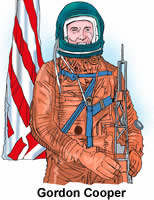
Dimdima
Online Children's Magazine from India

Dimdima
Online Children's Magazine from India

In August 1962, the Soviet Union treated the world to a space spectacular, involving two spacecraft, Vostok 3 and Vostok 4.
While Vostok 3 took off on 11 August with cosmonaut Andrian Nikolayev on board, Vostok 4 blasted off a day later. It was crewed by Pavel Popovich. The space twins circled Earth together but there was never any danger of them colliding. At their closest the two came within 6.5 kilometres of each other. The two cosmonauts communicated with each other through radio, the first ever ship-to-ship communication in space.
Both spacecraft returned to Earth on 15 August, landing within 15 minutes of each other and about 193 kilometres apart
Vostok 3 had orbited 65 times in 4 days, and Vostok 4, 48 times in 3 days. They were the longest space flights undertaken till then.
The cosmonauts seemed none the worse for their comparatively long stay in space, though doctors examining them did note that weightlessness seemed to have the effect of temporarily weakening the heart and muscles.
Two months later, on 3 October, the American astronaut Walter M. Schirra orbited Earth six times, spending a little over nine hours in space. There was one more flight scheduled in the Mercury series, and Gordon Cooper undertook this, in May 1963.
 Cooper’s 22-orbit flight lasted 34 hours, longer than all the previous Mercury missions combined. During the flight he tried out various space foods including a paste that had to be sucked out from a tube. He reported he could see topographical details on Earth, like roads and railway lines, and at times, even trucks and houses.
Cooper’s 22-orbit flight lasted 34 hours, longer than all the previous Mercury missions combined. During the flight he tried out various space foods including a paste that had to be sucked out from a tube. He reported he could see topographical details on Earth, like roads and railway lines, and at times, even trucks and houses.
His successful splashdown in the Pacific Ocean brought to an end America’s Mercury Project, which had been initiated in 1958 to put a man into space.
EXPLORE MORE...
Get Help or Give Help.
- Do you have a Science Question?
- Post it here and get the answer.
- Some questions posted by others are not yet answered.
- View those questions and answer them.
Dimdima is the Sanskrit word for ‘drumbeat’. In olden days, victory in battle was heralded by the beat of drums or any important news to be conveyed to the people used to be accompanied with drumbeats.
Bharatiya Vidya Bhavan
K. M Munshi Marg,
Chowpatty, Mumbai - 400 007
email : editor@dimdima.com
Bharatiya Vidya Bhavan
505, Sane Guruji Marg,
Tardeo, Mumbai - 400 034
email : promo@dimdima.com
Dimdima.com, the Children's Website of Bharatiya Vidya Bhavan launched in 2000 and came out with a Printed version of Dimdima Magazine in 2004. At present the Printed Version have more than 35,000 subscribers from India and Abroad.